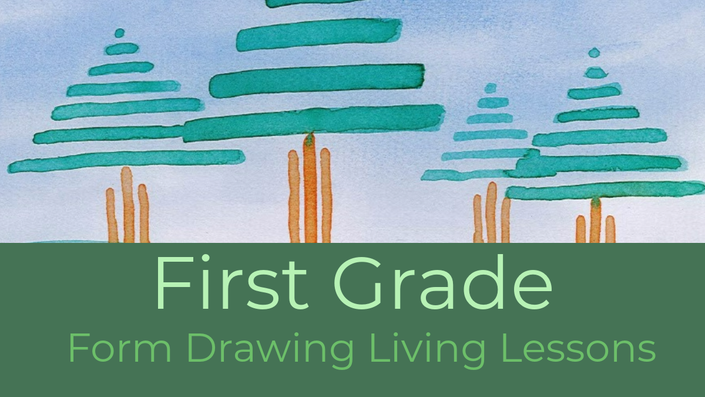
Waldorf Block: G1: First Grade Form Drawing
Explore the engaging world of Waldorf first grade form drawing, a foundational element of the curriculum designed to build essential skills for young learners. In Earthschooling Waldorf education, learning is a journey that emphasizes a holistic approach, integrating academics with artistic expression and hands-on experiences. Form drawing plays a crucial role in this process, fostering development in multiple areas. This block includes step-by-step instructions for teaching all the basic forms for first grade. It also includes the e-book “Waldorf Form Drawing Basics” and access to all the Main Lesson Book pages for first grade form drawing. This block is laid out in such a way that there is no teacher preparation for the lesson.
- Foundation for Learning: Beginning with simple straight lines and curves, children build a strong foundation for writing and geometry. These initial forms serve as the building blocks for creating letters, numbers, and more complex patterns as they progress through the grades.
- Multisensory Engagement: Form drawing engages children through visual, kinesthetic, and even auditory experiences. They can walk the forms, draw in sand, or visualize shapes, enhancing memory and cognitive processing.
- Fine Motor Skill Development: Drawing continuous, flowing lines refines hand movements, improves pencil control, and supports the development of good handwriting.
- Visual-Spatial Skills: Creating and reproducing forms develops spatial awareness and visual-spatial skills, crucial for understanding relationships between objects and space. This practice is linked to improved comprehension of geometric concepts and natural forms.
- Cognitive Benefits: Form drawing encourages concentration, crossing the midline, and the recreation of complex patterns, which all contribute to cognitive development. The repetitive nature of form drawing can also promote a state of mindfulness and reduce stress.
- Aesthetic Appreciation: Children are exposed to the beauty and harmony of forms found in nature, ancient art, and architecture, fostering an aesthetic sense.
- Preparation for Geometry: From tracing basic shapes to understanding symmetry and transformations, first grade form drawing lays the groundwork for later study of geometry in the middle grades.
- Interdisciplinary Connection: Form drawing seamlessly integrates with other subjects like language arts, history, and movement. For instance, letters might be introduced through stories and then drawn as part of form drawing practice.
In the Earthschooling Waldorf curr, first grade form drawing is a unique and valuable practice that nurtures the development of young children. By engaging children in this activity, educators help them develop essential skills for academic success and a lifelong love of learning. The focus is on the process of movement and exploration rather than just the final product, allowing children to truly internalize the forms and their significance.
Living Lessons are video lessons where a teacher leads the class through the main lessons for this grade. You can use these lessons as examples to follow for your own teaching or can use them as supplements to your own teaching (we all need a break now and then. I would have loved to have these available on days I was ill or was taking care of my fussy baby).
This listing includes the following Living Lessons (you can also see more details by scrolling down to see each class)
Form Drawing Mini-Lessons with Waldorf Teacher Nicole
Running Form #1:Waves
Running Form #2: ‘Cat Ears’
Form Drawing Running Forms & Mirrored Forms
Vertical Mirrored Form Drawing
Figure 8 Form
Form Drawing Lesson: Curved Lines
Form Drawing Lesson: Make a Rainbow
Form Drawing Lesson: Making Little Loops (Prep for Handwriting)
Spring Geese: Running Form Drawing
Rectangles Form Drawing
‘Greek Key’ Form Drawing
Complete Form Drawing Block with Waldorf Teacher Mellie
Form Drawing for the First Grade: Lesson One: The Line
Form Drawing for the First Grade: Lesson Two: The Curved Line
Form Drawing for the First Grade: Lesson Three: Part 1: The Circle
Form Drawing for the First Grade: Lesson Three: Part 2: The Circle
Form Drawing for the First Grade: Lesson Four: Part 1: The Spiral
Form Drawing for the First Grade: Lesson Four: Part 2: The Spiral
Form Drawing for the First Grade: Lesson Four: Part 3: The Spiral
Form Drawing for the First Grade: Lesson Five: Running Lines
Form Drawing for the First Grade: Lesson Six: Mirrored Shapes
Form Drawing for the First Grade: Lesson Seven: Mirrored Shapes #2 and Final Lesson
Form Drawing Stories with Teacher Janet
Form Drawing Story Adaptions by Janet
Main Lesson Video 1: The Straight Line and the Curved Line Story
Main Lesson Video 2: Straight Line Form Drawing with the Stories: The Legend of the Flute & The Grain of Corn
Main Lesson Video 3: Curved Line Form Drawing with the Story: Invitation to the Banquet
The Basics of Form Drawing
A Straight Line and Curved Drawing Lesson
Form Drawing Movement and More: MLB Triangle & Square
Adapted Story of Saint George and the Dragon and Form Drawing: Part One
Adapted Story of Saint George and the Dragon and Form Drawing: Part Two
The Tree That Longed for Other Leaves and Form Drawing
Your Instructor

Mellie Mae Lonnemann lives in Asheville, North Carolina with her husband and two sons. Mellie was a class teacher at the Green Meadow Waldorf School in Chestnut Ridge, NY before the arrival of her first son, Joseph. She then taught homeschool students morning lessons, clay art, quilting, and gardening. She taught handwork at the Asheville Waldorf School before the birth of her second son..Mellie received her Waldorf Teacher Certificate from Sunbridge Institute, a BFA with a concentration in ceramics from Alfred University, and an Art Certificate in Professional Maiolica from the Ballardini State Institute of Art in Faenza, Italy. Mellie loves spending time outdoors, being creative, and learning from her beautiful sons! She wishes to impart a love for learning through curiosity, discovery and creativity.
Course Curriculum
-
StartWritten Lessons for First Grade Form Drawing Block: Planner Format
-
StartWritten Lessons for First Grade Form Drawing Block: Block Format
-
StartForm Drawing Part I: Lesson 1: The Line (12:25)
-
StartForm Drawing Part I: Lesson 2: The Curved Line (13:03)
-
StartForm Drawing Part I: Lessson 3: The Circle: Part I & II (11:32)
-
StartForm Drawing Part I: Lessson 4: The Spiral, Parts I, II, and III (12:27)
-
StartForm Drawing Part I: Lessson 5: Mirrored Shapes: Parts I & II (27:37)
-
StartForm Drawing Part I: Lessson 6: Running Lines (15:37)
-
StartTHIS BLOCK IS NOW COMPLETE
-
StartForm Drawing Block II: Lesson 1: Running Form #1: Waves (3:04)
-
StartForm Drawing Block II: Lesson 2: Running Form #2: ‘Cat Ears’ (2:56)
-
StartForm Drawing Block II: Lesson 3: Form Drawing Running Forms & Mirrored Forms (4:56)
-
StartForm Drawing Block II: Lesson 4: Vertical Mirrored Form Drawing (1:26)
-
StartForm Drawing Block II: Lesson 5: Figure 8 Form (1:33)
-
StartForm Drawing Block II: Lesson 6: Form Drawing Lesson: Curved Lines (1:05)
-
StartForm Drawing Block II: Lesson 7: Form Drawing Lesson: Make a Rainbow (4:12)
-
StartForm Drawing Block II: Lesson 8: Form Drawing Lesson: Making Little Loops (Prep for Handwriting) (1:48)
-
StartForm Drawing Block II: Lesson 9: Spring Geese: Running Form Drawing (1:11)
-
StartForm Drawing Block II: Lesson 10: Rectangles Form Drawing (1:39)
-
StartForm Drawing Block II: Lesson 11: ‘Greek Key’ Form Drawing (1:33)
-
StartTHIS BLOCK IS NOW COMPLETE